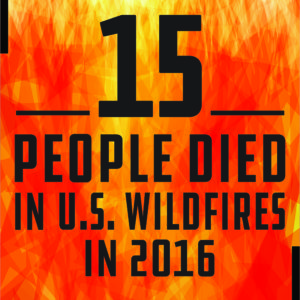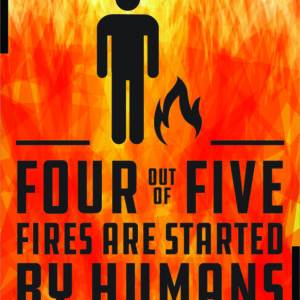

The Heat Is On

Case Exit

Josh McFadden
Depending on local climate and geography, the winter months can be agonizingly long. By the time spring finally rolls around, people are itching to get outdoors for some highly anticipated vacationing, recreating, and sightseeing without worrying about cold temperatures or snow.
Warmer weather entices more and more people to get out of their homes. It can also create ideal conditions for wildfires. Hot and dry is not a good combination for avoiding fires, nor is carelessness among campers and others enjoying the outdoors.
Summertime is definitely wildfire season.
In the Western United States, in particular, wildfires can keep dispatchers and firefighters busy. These fires can range from anything that may burn a few acres and be contained in a matter of minutes, to massive, destructive forces that burn uncontrollably for weeks and cause millions of dollars in damage.
What the numbers say
A brief look at wildfire statistics can be alarming and staggering. Statistics vary depending on the source, but there is an undeniable trend: Incidents of wildfires have been consistent for decades, and humans are usually the culprit. In fact, National Geographic reports that four out of every five fires are started by humans.1
In the United States alone, there has been an average of 64,248 wildfires per year since 2012. The 10-year average (2007–2016) is even higher at 73,304 per year.2 In 2016, 67,743 wildfires burned in the U.S., including 9,300 in Texas. However, in the last five years, even though there have been fewer fires per year, the fires have been more destructive, burning an average of 7.215 million acres per year. Conversely, between 2007 and 2016 the fires burned an annual average of 6.991 million acres.3 The year 2008 was particularly devastating, as there were 78,949 U.S. wildfires.4
According to the National Interagency Fire Center, 61,852 wildfires each year are started by humans. Also, human-caused fires burn 2.5 million acres annually. Conversely, lightning is the cause of 10,280 fires every year, amounting to 3.7 million burned acres. The Southwestern states, known for their hot, dry climates, have the most lighting-caused fires each year: 1,716.5
Loss of human life in wildfires is much lower than with structure fires. Since 1910, 1,114 people have died in wildfires (including 15 in 20166), whereas 3,275 people died in all types of fires in 2014.7

Wildfires are hardly isolated to the United States. In fact, 54 percent of the world’s wildfires occur in Africa.8 Between 2010 and 2014, there were 38,000 fires in Asia’s forests.9
Statistics show that fires in other parts of the world can be deadlier than they are in the United States. On Feb. 2, 2009, 180 people perished in a brush fire in Australia.10 Other examples of large death tolls in wildfires have occurred in the following locations: on Aug. 24, 2007, 65 people died in a forest fire in Greece; in May 1987, 191 people died in a forest fire in China; and in September 1997, 240 people lost their lives in Indonesia after a forest fire ravaged the area.11
The cost of national, state, and local agencies to fight and suppress these wildfires isn’t cheap. In 2014, U.S. wildfires cost $1.52 billion to put out. That number was down from $1.9 billion in 2012.12
Fire definitions
In the Fire Priority Dispatch System™ (FPDS®), wildfires are addressed in Protocol 67: Outside Fire. In Protocol 67, wildfires fall under the designation of WILDLAND Fires, which the protocol defines as “A forest, tree farm, or heavy brush fire, regardless of the type of vegetation.” Protocol 67 is used for four other types of fires: LARGE BRUSH/GRASS , SMALL BRUSH/GRASS, LARGE OUTSIDE, and SMALL OUTSIDE. Determinant Descriptors can also include LARGE OUTSIDE fire with hazardous materials and SMALL OUTSIDE fire with hazardous materials. This Protocol states that “Local Fire Administration must define and authorize for dispatch purposes what constitutes a LARGE BRUSH/GRASS fire in their area.
Be cautious when assigning a Determinant Descriptor to a WILDLAND fire, as it can easily be confused with a LARGE OUTSIDE fire.
Protocol 67 uses Determinant Suffixes to help delineate what is being threatened by the fire. WILDLAND fires may include the following suffixes: A = Animals; B = Buildings (non-residential); O = Other; P = People; R = Residential; U = Unknown; V = Vehicle; X = Single injured person; Y = Multiple injured persons.
Protocol application
In Case Entry, if the caller reports a fire in a forest, tree farm, or in some brush and says that someone is on fire, you will code the call as 67-E-1 “Person on fire (outside)” and dispatch immediately. At this point, the call is coded for Person on fire, not WILDLAND, even though the fire in question is a WILDLAND fire. You would then give the appropriate PDIs.
Once in Protocol 67, Key Question 1 instructs the dispatcher to say to the caller, “Tell me exactly what is burning.” After receiving this response, the dispatcher will ask, “What size of area is burning?” Remember, the caller may not have an exact description of how large it is, so encourage the person to estimate as best as he or she can. Rule 6 can be helpful here: “If the caller struggles to determine the size of the fire, ask them to relate it to the size of a familiar area (e.g., football field, tennis court, etc.).” This can be especially helpful when trying to describe a WILDLAND fire.
Your caller’s answers to Key Questions 1 and 2 will help you determine whether this is a WILDLAND fire or one of the other possibilities. Next, ask Key Question 3, “Is the fire threatening anything?” You may need to press the caller for specifics such as whether animals, people, buildings, or vehicles are in harm’s way. Rule 2 guides you by instructing, “The determination of whether a fire is threatening a building should be based on the caller’s judgment.” If the caller isn’t sure whether any buildings are threatened, you need to assume that they are.
In a different scenario, if no one was on fire and you coded the call as a WILDLAND fire (67-D-1), Key Questions 1, 2, and 3 previously discussed would be applicable here. In this case, at this point you would dispatch firefighters to the scene. Don’t forget to include the appropriate Determinant Suffix.
In the 67-D-1 call, you would then give the following PDIs:
- I’m sending the fire department to help you now. Stay on the line, and I’ll tell you exactly what to do next.
- Do not try to put the fire out.

Make sure you return to Key Questions and ask whether anyone is in immediate danger. Key Questions 6 and 7 ask, “Is the fire spreading?” and “Is anyone injured?” You can omit Key Question 8, “Do you know the warning placard numbers (chemical ID) of the hazardous materials?” if this is not a HAZMAT situation, unless you are certain such materials are involved in the WILDLAND fire. A HAZMAT incident involves a gas, liquid, or solid that, in any quantity, poses a threat to life, health, or property.
Protocol 67 has one Axiom, which is directly applicable to our discussion on WILDLAND fires. It says, “WILDLAND fires, especially fires in canyons, are very dangerous and unpredictable.”
“Fires in canyons tend to burn and move up,” said Mike Thompson, PDS™ Program Administrator—Fire and Medical. “The fire preheats the fuel ahead of it, which makes it easier for it to ignite, and when it does, it does so quickly and at times explosively dependent on the fuel moisture content. These things will make a fire move up the side of a canyon extremely quickly, and the steeper it is, the quicker it will move. A fire will move up a hill much faster than a human being can run up it. In addition, canyons tend to be places where winds are unpredictable and gusty, which compound the problem, making the fire behavior unpredictable and erratic.”
In a WILDLAND fire call, if the caller isn’t in danger and there are no HAZMAT issues, you will link to X-1 for Case Exit. If the caller’s life is in danger but the person is not trapped, link to B-2. Here, you will instruct the caller to leave the area immediately if it is safe to do so. Tell the caller not to return to the area for any reason. Also, remember to ask whether they can take their phone with them. If this isn’t possible, give the following instruction: “Call us back from a safe location, if possible. If you can’t call us back, make yourself known to the firefighters (responders) when they arrive.”
HAZMAT dangers require you to use B-4.
Conclusion
Wherever your agency may be located, WILDLAND fires are a possibility, especially if you are in the American Southwest or Australia, where fires are prevalent during the hot, dry months of the year.
The key to determining whether the call should be coded as WILDLAND fire or LARGE OUTSIDE fire is by assessing what the area is like where the fire is burning. If the fire is occurring in a forest, tree farm, or in heavy brush, it should be considered a WILDLAND fire.
Though WILDLAND fires are not the deadly killers that structure fires can be, they are difficult to predict and can spread easily and quickly.
Sources
1 “Wildfires.” National Geographic. National Geographic Society. 2015. http://www.nationalgeographic.com/environment/natural-disasters/wildfires/ (accessed April 17, 2017).
2 “Compare Annual Wildfire Statistics.” FindTheData. Graphiq, Inc. 2017. http://www.wildland-fires.findthedata.com (accessed April 17, 2017).
3 See note 2.
4 See note 2.
5 “Wildland Fire Fatalities by Year.” National Interagency Fire Center. 2016. http://www.nifc.gov/safety/safety_documents/fatalities-by-year.pdf (accessed April 18, 2017).
6 See note 5.
7 “U.S. fire statistics.” U.S. Fire Administration. 2017; Jan. 31. http://www.usfa.fema.gov/data/statistics/#tab-2 (accessed April 18, 2017).
8 Larsen J. “Wildfires by Region: Observations and Future Prospects.” Earth Policy Institute. 2009. http://www.earth-policy.org/images/uploads/graphs_tables/fire.htm (accessed April 18, 2017).
9 See note 8.
10 “The 10 most significant wildfire events based on the number of fatalities from 1910 to 2016.” Statista. 2016. www.statista.com/statistics/267801/death-toll-due-to-wildfires (accessed April 19, 2017).
11 See note 10.
12 See note 2.







